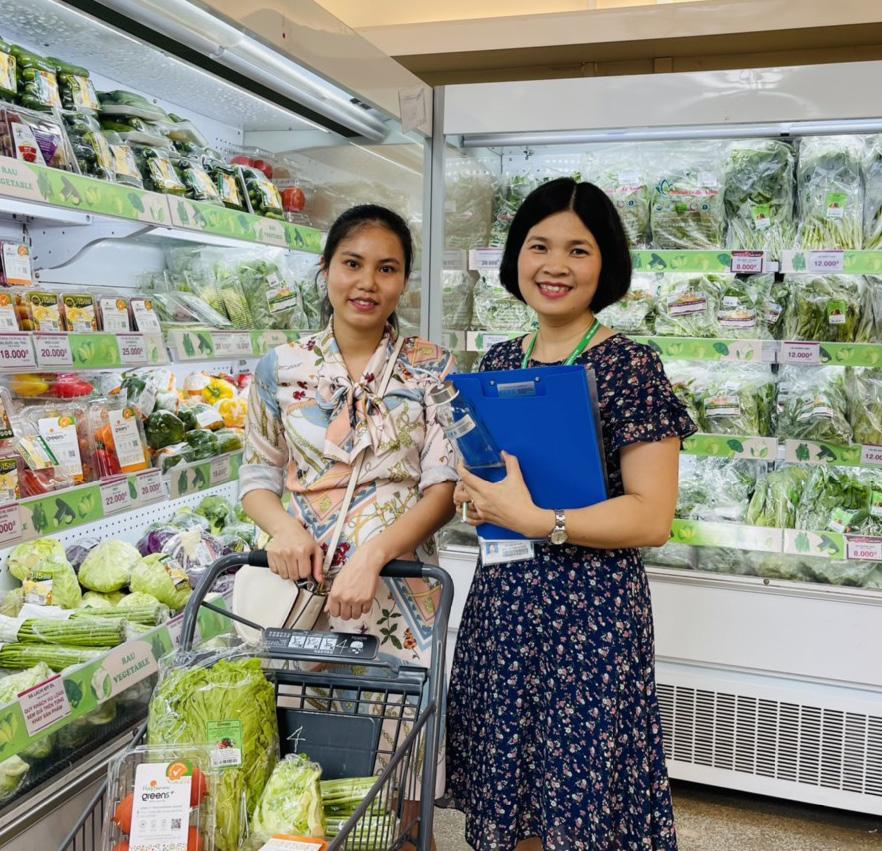
11 minute read
Advanced Grants awarded in 2021
by IFS
Advanced Grants given in 2021
We implemented the new Advanced Grant scheme in 2021 in collaboration with Philippines-based SEARCA3 with a Call for Research on Accelerating Transformation through Agricultural Innovation in Southeast Asia. The theme was selected in response to the COVID pandemic. We received 52 Advanced Grant applications for pre-screening, with 32 then sent out for external review and to SAC members. Twenty-seven (27) applications were recommended for continued consideration, with ten grants eventually awarded, as below.
DR BUI THI LAM, VIETNAM
Moving toward a healthier diet: Consumer intention to eat more vegetables and less meat in Vietnam
Since the 90s, the dietary pattern in Vietnam has remarkably shifted towards unhealthy diets high in animal protein but insufficient in fiber. While malnutrition is prevalent among a proportion of the rural population, cities are facing an increased rate of overweightness and obesity. Unbalanced diets that favour meat have been linked to large greenhouse gas emissions, therefore posing a considerable risk to the environment, as compared to plant-based diets. A healthier diet with less meat and more vegetables is the key solution for such a health and environmental crisis. This project will analyse the characteristics of distinct consumer segments across different stages of behaviour changes in meat and vegetable consumption in Vietnam; and investigate the intention to eat more vegetables and less meat, along with the association between the two practices. This project will contribute to the existing literature and provide comprehensive evidence-based recommendations to facilitate a shift toward more plant-based diets in Vietnam.
DR OANH NGUYEN CONG, VIETNAM
Potential for using some indigenous medicinal plants as feed additives relating to animal health, growth performance and meat quality of pigs in Northern Vietnam
Overuse of antibiotics for growth promotion and disease prevention in animals can contribute to the emergence of antibiotic resistance and to increased human health risks. Phytogenics have been studied and used in animal feeds as replacements for antibiotics. Some indigenous medicinal plants in pig diets can improve digestive health and growth performance while others can enhance carcass characteristics, sensory quality and fatty acid compositions of pork. However, little is known about the effect of locally phytogenic additives in pig diets on growth performance, carcass characteristics and meat quality of pork. Thus, this project will survey availability and use of indigenous medicinal plants as feed additives in pig production in Northern Vietnam, and analyze their chemical constituents, bio-active compounds and antioxidant capacities. It is expected that the results of this project will be a good basis for scientists to develop feed production strategies for animals based on local resources of indigenous plants in Vietnam.
MS MILDRED GUIRINDOLA, PHILIPPINES
Food environment and socio-ecological attributes as drivers of food security before and during enhanced and general COVID-19 quarantines in Cavite, Philippines
The Philippines is noted to have a stricter and longer duration of quarantines than in other parts of the world. The imposed quarantine, depending on its level of restrictions, heavily affected the mobility of people that resulted in decreased availability and affordability of food and loss of jobs and livelihoods. Currently, there is a gap in how the quarantine restrictions affect households’ food behaviour and food choices and their food security based on the way they obtain and or buy, prepare, store, cook, and consume their food with their inherent socio-ecological factors. There is also a gap on how the changes in food supply and demand in the community brought about by the quarantine affect food retailers and the foods they sell, and how they evolve to keep their food retail market in operation despite the pandemic. There is also a need to know if the safety net programs of the government were able to ameliorate poor people’s access to nutritious food based on the timing of quarantine restrictions imposed by the government. This study aims to provide holistic information on how the COVID-19 quarantine restrictions affect the households’ consumer behaviour and food security based on the changes in their food environment. This study is critical in developing post-pandemic policy recommendations towards improving the food environment and food security of the most vulnerable sectors of the population living in a peri-urban and varying landscape environment.
DR TRAN NGUYEN DUY KHOA, VIETNAM
Application of light-emitting diodes (LEDs) in larviculture of mud crab (Scylla paramamosain)
Light, including its rhythms, quality and intensity, is a key environmental factor influencing the growth, culture and survival of aquatic organisms. Throughout development and evolution, organisms gradually adapt to different lighting conditions through changes in their physiology, morphology and behaviour. Based on the various physical and chemical properties of light, artificial conditions should therefore aim to simulate natural lighting characteristics to encourage the growth and development of aquatic organisms and promote a healthy and sustainable aquaculture industry. Mud crab (Scylla paramamosain) is a valuable aquatic species to the aquaculture indu-
Dr Bui Thi Lam conducting a face-to-face interview on how to change unhealthy food habits. Mastering the operation of a UV-Vis spectrophotometer. Left: Dr An Quoc Trieu, at the computer his undergraduate student, Khang Duy Hoang.
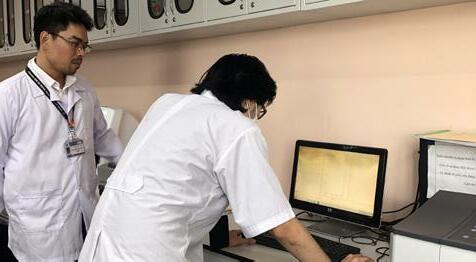
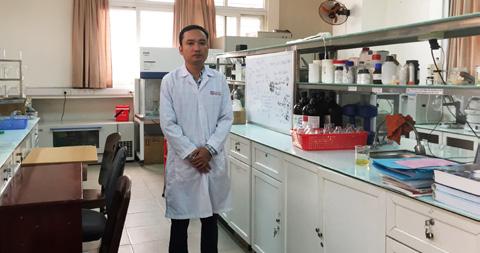
Thien Nguyen in the biotechnology lab of Duy Tan University.
stry. However, the current technology for mud crab larviculture is facing mass mortality during larval metamorphosis. Importantly, the light quality is considered as one of the critical factors to improve the rearing technology of mud crab due to light quality effects on behaviour activity or moulting rates, feeding rhythms, food intake, and innate immune responses. This study aims to provide more comprehensive insights into the optimal spectral environment of mud crab larvae. Through evaluation of biometric performance (e.g., growth, metamorphosis, survival), digestive capacity, stress and innate immune response) of mud crab larvae under different LED light spectra, intensities and rhythms, this study can suggest appropriate LED lighting in the mud crab hatchery, which can bring more profit for farmers as well as contribute to the sustainable development of mud crab culture.
MR THANH DIEN LE, VIETNAM
Isolation and characterization of bacteriophages for biocontrol of multidrug-resistant Campylobacter jejuni in broilers
Vietnam was often considered a hotspot for emerging infectious diseases. Campylobacter jejuni is responsible for the majority of cases of Campylobacteriosis in humans (one of the most frequently reported foodborne illnesses). A previous study in Hanoi (Vietnam’s capital) showed that approximately 30% of raw chicken in school and hospital canteens and at retail markets contain Campylobacter spp. Moreover, thermophilic campylobacters from 35.1% of chicken carcasses in large and small abattoirs of Ho Chi Minh City (the biggest city of Vietnam) were isolated and 67.9% of the isolates belonged to the species C. jejuni. The contamination with C. jejuni during broiler slaughter and processing represents a high risk of Campylobacteriosis transmission. The reduction of C. jejuni in broilers can contribute to decreasing human Campylobacteriosis significantly towards food safety. Bacteriophages are one of the potential approaches to reduce C. jejuni counts in broilers. Nonetheless, the diversity and evolution of C. jejuni in nature are the main reasons to pave the efforts to find novel lytic bacteriophages against multidrugresistant and phage-resistant C. jejuni. This project will isolate, identify, and characterize lytic bacteriophages specific for multidrug-resistant C. jejuni in broiler fecal matter and fresh chicken meat in Tien Giang Province, Vietnam. The isolated lytic bacteriophages and their suitable characterizations will be critically potential material for further promising projects to apply bacteriophages in broilers and the poultry industry and to reduce the risk of Campylobacteriosis in humans in Vietnam and other vulnerable countries.
MR HUU TIEN NGUYEN, VIETNAM
Study on damaging potential and diversity of plant-parasitic nematodes associated with vegetables in Vietnam and development of biological control strategies using endophytic bacteria
Nematodes are one of the most numerous metazoans on our planet. They can be animal parasites, plant parasites, insect parasites, or free-living nematodes. Among them, plant-parasitic nematodes (PPNs) are one of the most damaging pests to plants, affecting directly the food security and economy of humans. PPNs are capable of causing damage to all parts of plants such as stems, leaves, flowers, fruits, or roots. Each PPN group causes different levels of damage, and the total damages caused by PPNs are estimated at 157 billion USD per year worldwide. Although studies on plantparasitic nematodes in Vietnam have been carried out since 1970, they are still quite scattered and limited, only at the level of symptoms recognition, without damage assessments and nematode management. Therefore, this project will investigate and evaluate the damage and
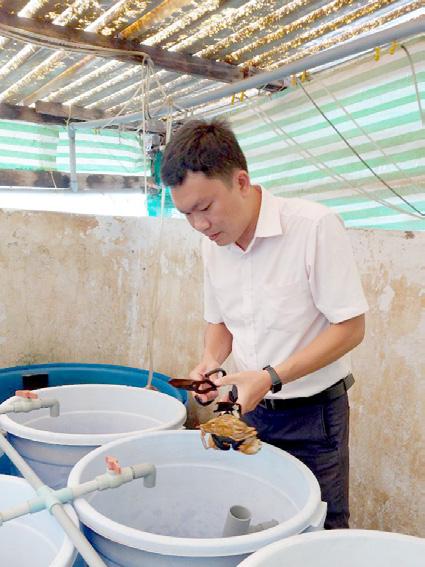
Dr Tran Nguyen Duy Khoa, Vietnam, with daily work in crab hatchery. Dr Magdalena Lenny Situmorang, Indonesia. Water quality measurement in closed hybrid ZWDRAS system for shrimp growout.
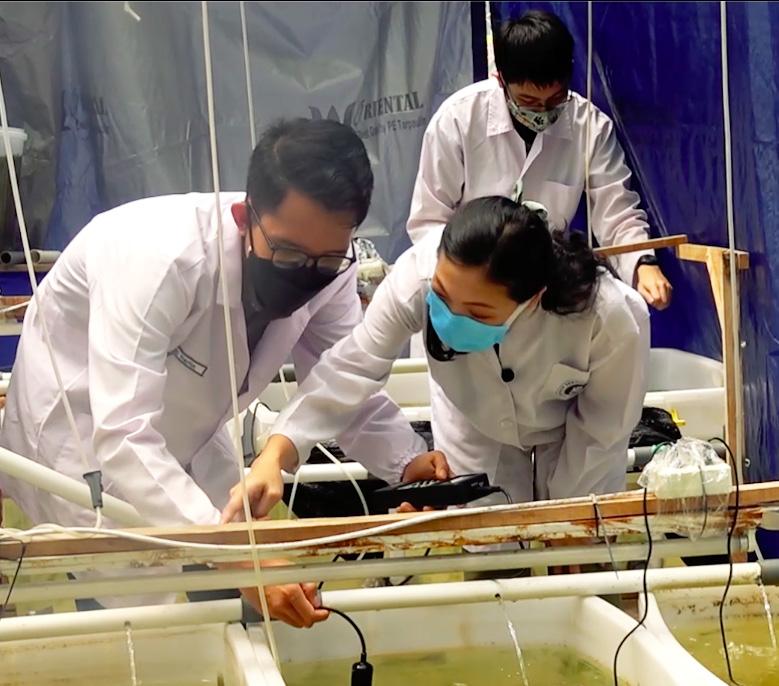
host range of PPNs associated with vegetables in Vietnam; identify and study the diversity and phylogeny of PPNs associated with vegetables in Vietnam, to provide morphological data and DNA barcodes for future research; evaluate the potential of endophytic bacteria in controlling selected PPN (Meloidogyne spp.); and build an online database from the achieved results to facilitate the prevention of PPNs as well as to create a basis for sustainable agricultural development.
DR THIEN NGUYEN, VIETNAM
Experimental and computational NMR in detection, structure elucidation, and kinetic analysis of lipid oxidation products in fried foods in Vietnam
Cytotoxic and genotoxic lipid oxidation products (LOPs), such as peroxides, aldehydes, ketones, and alcohols, generated in culinary frying oils during hightemperature frying practices, may pass into fried foods, causing high risks of non-communicable diseases, including cardiovascular diseases and prostate cancer, for regular consumers. Therefore, the method developments for detecting and identifying LOPs in fried foods are of interest to both producers and customers. Nuclear magnetic resonance (NMR) has been an invaluable tool for food compositional analysis, structure elucidation, and formation mechanism due to its ability to provide important structural information without the need for sample purification. In addition, the advancements of computational NMR have tremendously supported the difficult assignments of complex structures. The support of computational NMR would be significantly useful for solving difficult assignments and unstable peroxides. By unravelling the composition, the structures, and formation mechanism of LOPs in fried food, the proposed research will provide solid evidence about the presence of LOPs in fried foods, to raise the awareness of LOPs, and to contribute to the establishment of a fair market.
DR MAGDALENA LENNY SITUMORANG, INDONESIA
Application of closed hybrid Zero Water Discharge–Recirculating Aquaculture System technology along with synbiotic functional feed as alternative to antibiotics for disease biocontrol strategy in whiteleg shrimp (Litopenaeus vannamei) culture: An approach to reduce antimicrobial resistance towards sustainable shrimp industry through the One Health lens
The Asian continent is of great significance to international shrimp supply, but as shrimp aquaculture intensifies to meet global demand, so does the disease burden affecting the shrimp culture. The emergence of bacterial diseases, including the ones caused by Vibrio sp., had resulted in heavy losses in global shrimp production. Antibiotics are extensively used as prophylactics against bacterial pathogens, which carries important disadvantages including the residues in shrimp products that can lead to antimicrobial resistance. Therefore, sustainable solutions to replace antibiotics usage and increase system resilience in the shrimp industry are significantly and urgently needed. Best farming practices through improved farming systems and use of better feed are likely to reduce antibiotics resistance. A closed hybrid Zero Water Discharge-Recirculating Aquaculture System (ZWD-RAS) offers the simplicity and the high level of microbial control of the ZWD system, and the high water quality controlling capacity of the RAS system with less operational (electricity) cost. Overall, this project aims to evaluate the application of the closed hybrid ZWD-RAS system along with synbiotic functional feed as alternative to antibiotics for disease biocontrol strategy in whiteleg shrimp farming, with emphasis on reducing antibiotics usage as an approach to reduce antimicrobial resistance towards sustainable shrimp industry in Indonesia that prioritizes not only the animal and the environment
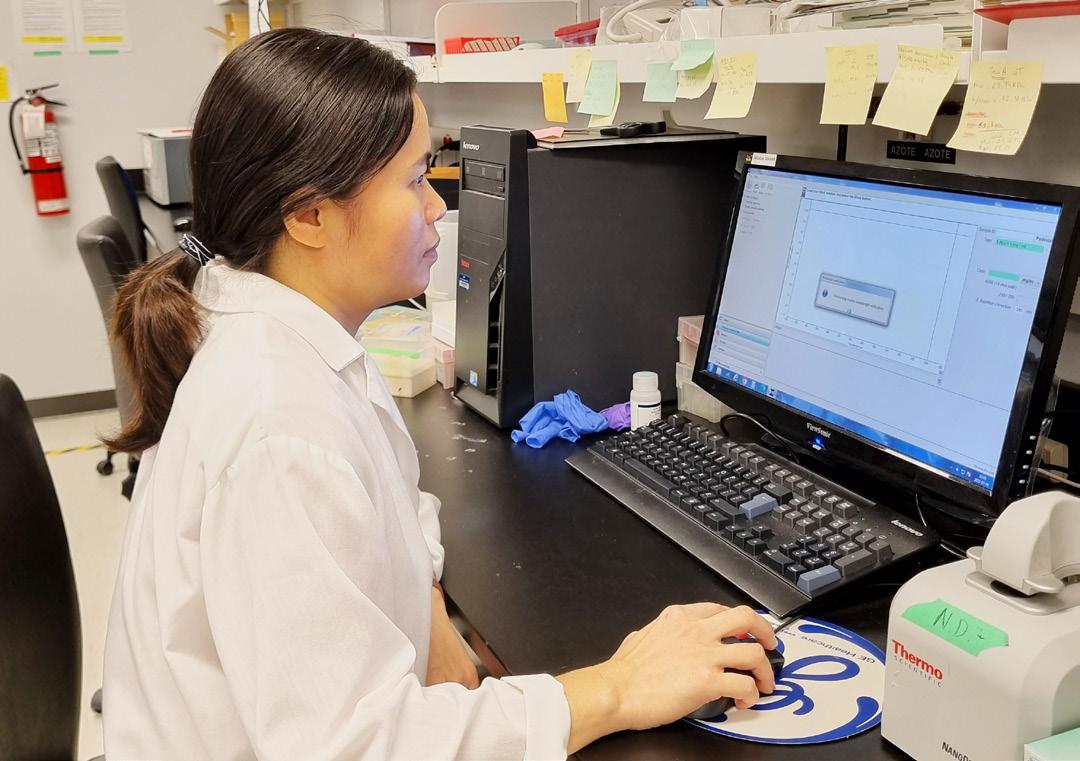
Dr Nguyen Thi Tam Thu, Vietnam, measuring protein concentration on nanodrop.
but also human health, as in the “One Health” notion.
DR NGUYEN THI TAM THU, VIETNAM
Production and characterization of polyhydroxyalkanoate (PHA) by halophilic microorganisms isolated from Truong Sa island in Vietnam
Polyhydroxyalkanoate (PHA) is a bioplastic that can be degraded in a marine environment. It is a group of polymers formed from hydroxyalkanoate monomers that are linked together by ester bonds. PHA can be biosynthesised by bacteria and Achaea, both normal and halophilic bacteria. Many authors studied bacterial groups that can produce PHA such as Burkholderia, Candidatus, Caulobacter, Comamonas, Halomonas, Halococcus, Rhodobacter, Roseobacter, Paracoccus and Sphingomonas. Among them, Halomonas and Halococcus are halophilic bacteria that can produce PHA with high efficiency. These halophilic bacteria are also present in Truong Sa island and are capable of producing pyruvate and PHB. However, there is no study about PHA producing halophilic bacteria and PHA structure in this sea.
DR QUOC AN TRIEU, VIETNAM
Recovery of phosphate from eutrophic water bodies by nano-biocomposite adsorbents: Application as smart fertilizers
Global food production relies mostly on the use of fertilizers and P-containing pesticides for the treatment and protection of crops. Lately, it has been realized within the scientific community that the current practices in the P supply chain are not sustainable in the long term. Common practices of applying P-based fertilizers and their gradual enrichment in water reservoirs lead to eutrophication, which causes the overgrowth of harmful algal blooms and degradation of water quality. Therefore, the aforementioned issues could be resolved simultaneously if a water treatment process that could take into account this double-faceted issue is researched and developed. The aims of this project include fabricating nano-biocomposites adsorbents based on the concept of integrating hydrated nano-oxides into the natural polymeric network including chitosan and agricultural waste such as spent coffee grounds; extensively studying the phosphorus adsorption of the as-synthesized bio-sorbents; and preliminarily assessing the applicability of as-synthesized P-load nano-biocomposites as smart fertilizers. In addition, the philosophy of the circular economy could be satisfied in this project in which reusing, refurbishing, remanufacturing, and recycling processes are promoted. The principles of green chemistry will be addressed in the synthesis of materials such as the use of renewable feedstock, mild conditions, and the reduced use of hazardous chemicals.








